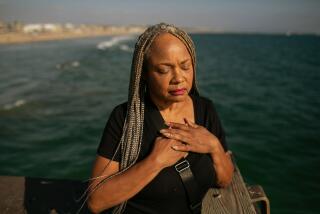Mother Faced Her Fears of Huntington’s : Survivor: Woman worried for decades after her own mother was stricken. She and her children are safe, but her brother wasn’t so lucky.
- Share via
One woman with a very personal hope that John Wasmuth will find the gene that causes Huntington’s disease is Karen Sweeney.
Sweeney, of Sterling, Va., is 33 years old now, with sparkling green eyes and long blond hair, a classically handsome husband and four fine-looking kids. Sweeney was 6 months old when her mother was institutionalized for Huntington’s disease.
“Some of my most vivid memories as a child,” Sweeney said, came when “every Wednesday and Sunday my father and grandmother would go and visit my mother” in the Hackett Home for Incurables, a part of Norristown State Mental Hospital in a Philadelphia suburb.
Hospital rules barred minors from the hospital. “I would sit in the car for two or three hours while my father and grandmother went in to visit my mother. All I remember is sitting in this car and looking at this building. It was like something out of one of those black-and-white movies about a mental institution, very austere and foreboding.”
A nurse finally took pity on Sweeney when she was 8 and “snuck me in. . . . I remember walking through the lobby, the halls, the lost souls with the looks in their faces, the screams down the corridors. . . .
“The first thing I remember is my mother was in a bed with leather straps on her arms and her legs, tied to the bed. She had bruises on her arms and legs from banging into the bed. They had to strap her down for her protection.”
Her mother couldn’t talk, though Sweeney swears that on one visit she heard her say, “It’s Karen.” When Sweeney was 11, her mother died.
Knowing that she was at risk for the disease and thus was unlikely to live the normally allotted threescore and ten, Sweeney says, she fell into “a lot of bad things, drugs and being bad and running away.”
Three years after her mother’s death, her father gave her over to the state and Sweeney started shuttling among foster homes. She wound up with a couple she calls “former hippies” who changed her attitude and helped her gain entrance into a private prep school where for the first time she excelled academically.
After graduating she married a man who has become a career soldier and they started having children. “At the time I felt that I was not going to have any kind of future career-wise. . . . The only thing I wanted out of life that I felt I never had was a family. I never knew my mother and I wanted so much to feel that motherly love or compassion or whatever.
“The only way I could get it was by being a mother. . . . The only thing I wanted out of life was to have children. My rationale was I knew the risk I was taking, that my children might get (Huntington’s), but at the same time, 30 years from the time I had my children was a lot of time for medical science to progress.
“And my kids would have a life with a mother, which I didn’t have.”
In 1981 researchers had come up with a means of testing for Huntington’s. It wasn’t 100% accurate, and it often required numerous family members to be tested so scientists could compare genes. But in 1986, Sweeney got accepted into a testing program at Johns Hopkins Hospital in Baltimore and her husband wrangled an Army transfer to Fort Lee, Va.
By then Sweeney was 28, close to her mother’s age when she started showing symptoms. She wanted to know.
Sweeney went through a year of counseling, preparing her to handle the news--good or bad. Social workers repeatedly asked her if she was sure she wanted to go through with the test.
Finally, the researchers tested her blood. Sweeney says they told her they did not expect a conclusive answer because she had so few family members to give blood: her father, her mother’s uncle, her brother. Did she still want to know? Yes.
The testing done, “we had to wait. That was the worst part, we had to wait two weeks to find if there was a conclusive answer. They told me beforehand they couldn’t tell me over the phone whether (the results were) positive or negative.”
“I was at home doing housework and dishes” when she was told that the researchers had a conclusive reading. It took two weeks to arrange a session to learn the results.
“Those last two weeks after we knew there was a positive answer were probably the most stressful, difficult two weeks of my life.”
Karen wore a pretty dress to Johns Hopkins, and her husband, Paul, donned a three-piece suit. “This was a special day. We looked at each other in the parking lot and said, ‘This is it, kid, we can do it.’ It was a real pep talk.”
They entered the hospital and were asked again, did they want to know. Yes.
The researchers told Sweeney they were 95% certain she would not develop Huntington’s; thus, she would not pass it on to her children. She felt “elation . . . relief. The first 28 years of my life I thought I was going to have it.”
The Sweeneys left the hospital, drove to his relatives’ house and passed the good news to their children. “It’s an amazing relief. It’s like some big, dark cloud all of a sudden being gone. It was amazing.”
In the years since she got the good news, Sweeney went from being “pretty dependent, passive,” to a woman who thinks “what I can do is unlimited.” She returned to college and also works as a hostess and cashier at a Maryland conference center.
Sweeney’s brother, Thomas, doesn’t share her luck.
Several years ago, the brother started having problems. “He’d fall at work or have some kind of accident with a hammer” as he worked construction, or “minor fender benders” in his car, she recalls.
Now he’s 44 and has not been able to work for years. He’s just barely able to stay out of an institution as the Huntington’s symptoms worsen, Sweeneys says. “Even to this day, he believes he’s going to get better and he’ll be back to normal again,” she says. She knows better.
Speaking of Wasmuth and his search for the gene that causes Huntington’s, Sweeney says, “Oh boy, I hope he finds it. . . . I wish (researchers) could go faster . . . and help my brother.”
More to Read
Sign up for Essential California
The most important California stories and recommendations in your inbox every morning.
You may occasionally receive promotional content from the Los Angeles Times.













